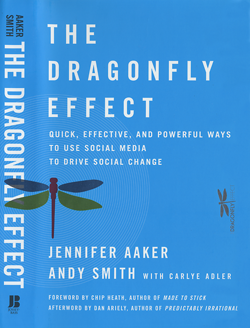Jennifer Aaker and Andy Smith:The Dragonfly Effect: Quick, Effective, and Powerful Ways to Use Social Media to Drive Social Change

2010, 236 pages, Jossey-Bass, San Francisco
We've all experienced how online social media are changing the way we relate to each other. But we're only beginning to understand how to use these technologies to engage and empower online communities to make a real difference in the world. The Dragonfly Effect seeks to be "a playbook for moving your cause from awareness to action" and is a valuable resource for individuals and organizations wanting to create social change in the modern world.
Social media can be especially useful for arts nonprofits, as they provide inexpensive and efficient ways to reach people. Yet nonprofits must be careful not to be so seduced by the ease and immediacy of Facebook, Twitter, and the like that they risk not first understanding their target audiences and strategizing appropriately.
In making this more than a how-to book on creating a successful social media campaign, the authors join behavioral research and consumer psychology with practical approaches to the goal of harnessing the powers of social media for social change. The reader is reminded that social networking technologies are simply the tools through which the energy of participation and a sense of purpose in supporters are funneled. The story told and the relationships built are what is important, not the tools of social technology themselves.
There are examples of successful campaigns ranging from bone marrow donations and raising money for infant incubators to an anti-methamphetamine publicity campaign and helping elect Barack Obama president. Also included are worksheets to help home in on the concepts behind your campaign (even more would be helpful). The flowcharts throughout are useful, as are tips including how to write an e-mail that inspires action; how to use a blog's power of human connection; and a list of types of requests for various purposes.
For those not yet adept at Facebook, Twitter, and other social media tools, brief "boot camps" give an overview, and it would be even more helpful if they elaborated on or gave examples of what to post or tweet. Interestingly, there is only a brief mention of Facebook Causes, a tool created specifically for fund-raising campaigns.
The ideas in The Dragonfly Effect are well worth exploring — not only regarding the social media tools to use but, more important, the reasons and strategies for using them. In fact, much of what the authors present is helpful information for any fund- or awareness-raising campaign, whether or not it's using online social media tools.
